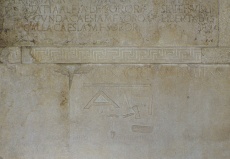Square
From Inventions
(Created page with '{{Template invention |nome= Name in use since the Middle Ages (from the Latin ''ex-quadrata'', referring to ''norma''=square, i.e., instrument for drawing squares). In the Middl…') |
|||
| (One intermediate revision not shown) | |||
| Line 20: | Line 20: | ||
|strumentiesistenti= | |strumentiesistenti= | ||
| + | - Museum of the History of Science, Oxford <br> | ||
| + | [http://emu.mhs.ox.ac.uk/Display.php?irn=10424&QueryPage=%2FAdvQuery.php Museum of the History of Science, Oxford, inv. 21717]<br> | ||
| + | [http://emu.mhs.ox.ac.uk/Display.php?irn=2782&QueryPage=%2FAdvQuery.php Museum of the History of Science, Oxford, inv. 37997]<br> | ||
| + | [http://emu.mhs.ox.ac.uk/Display.php?irn=1687&QueryPage=%2FAdvQuery.php Museum of the History of Science, Oxford, inv. 38074]<br> | ||
| + | [http://emu.mhs.ox.ac.uk/Display.php?irn=2783&QueryPage=%2FAdvQuery.php Museum of the History of Science, Oxford, inv. 52061]<br> | ||
| + | |||
| + | |||
|link= | |link= | ||
| Line 26: | Line 33: | ||
Image: 8528_3202_1692-012.jpg |Ara di Lucius Alfius Statius (dettaglio), vi sono riprodotti un regolo di due piedi romani, un archipenzolo, un compasso, una squadra e un martello. Aquileia, Museo Archeologico Nazionale.<br /> | Image: 8528_3202_1692-012.jpg |Ara di Lucius Alfius Statius (dettaglio), vi sono riprodotti un regolo di due piedi romani, un archipenzolo, un compasso, una squadra e un martello. Aquileia, Museo Archeologico Nazionale.<br /> | ||
| - | |||
| - | |||
Current revision as of 10:12, 8 September 2010
Name in use since the Middle Ages (from the Latin ex-quadrata, referring to norma=square, i.e., instrument for drawing squares). In the Middle Ages it was also called orthogonium (from the Greek orthos=right and gonia=angle). In the Renaissance the words giusta (just) or che fa l'algolo retto (that which makes a right angle) were added if the square had orthogonal fixed sides, zoppa (lame) or snodata (disjointed) if it had a mobile arm to form angles other than right angles.
Contents |
Description
Instrument for tracing right angles. Along with the ruler and the compass, the square forms part of what Vincenzo Scamozzi deemed "the instruments most proper to the Architect". A wooden square for measuring heights (orthogonium) is described by Gerbert d'Aurillac (Pope Silvester II), Leonardo Fibonacci and Villard de Honnecourt. The instrument allowed only one inclination of the visual ray along the line of the hypotenuse. The surveyor had to move backward until he intercepted the point to be sighted.
Bibliographical Resources
Papa Silvestro II, Geometria incerti auctoris, in Gerberti postea Silvestri II papae Opera matematica, (972-1003). Hildesheim, Georg Olms Verlagsbuchhandlung, 1963, III, 16.
Fibonacci, Leonardo, La Pratica di Geometria. Volgarizzata da Cristofano di Gherardo di Dino cittadino Pisano,dal codice 2186 della Biblioteca Riccardiana di Firenze, a cura e con introduzione di Gino Arrighi. Pisa, Domus Galileiana, 1966, VII, p. 202.
Villard de Honnecourt, Album di disegni, Biblioteca Nazionale di Parigi, ms.19093, c.20v.
Villard de Honnecourt. Kritische Gesamtausgabe des Bauhüttensbuches ms. fr. 19093 der Pariser Nationalbibliotek, Herausgegeben von Hans R. Hahnloser, Wien, A. Schroll, 1935.
Existing Instruments
- Museum of the History of Science, Oxford
Museum of the History of Science, Oxford, inv. 21717
Museum of the History of Science, Oxford, inv. 37997
Museum of the History of Science, Oxford, inv. 38074
Museum of the History of Science, Oxford, inv. 52061
Images
Author of the entry: Filippo Camerota

